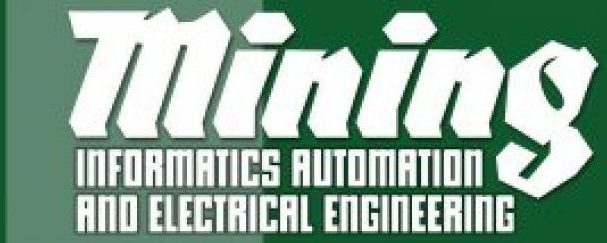Sławomir Straszak, Artur Wiktor
SHEAVE AXLES OF MINE SHAFT HOISTS – DIFFICULTIES AND LIMITATIONS IN ASSESSING THEIR TECHNICAL CONDITION DURING IN-SERVICE TESTS
The paper discusses the difficulties and limitations in the possibility of assessing the technical condition of sheave axles during inservice tests resulting from the lack of access to many areas of the outer surface of the axle due to built-in bearings and mounted sheaves, as well as from the complex shape of some types of axles. Examples of in-service axle failures are given and the causes are discussed. In addition, information on the legal basis for performing non-destructive testing of sheave axles in service, technical requirements for sheave axles, critical areas found in axles, theoretical basis for ultrasonic testing, and testing techniques including the latest phased array method is presented.
https://doi.org/10.7494/miag.2021.4.548.7
Bronisław Biel
INNOVATIVE HYDROMECHANICAL CLEANING OF MINE WATER SEDIMENTATION TANKS IN UNDERGROUND HEADINGS
In mines, water from natural inflows as well as process water from fire protection systems is usually stored in sedimentation tanks, located primarily at the lowest level of the mine. Such water usually contains mechanical contaminants, undergoing the process of sedimentation. The article presents a method enabling the cleaning of mine water sedimentation tanks. The method involves jet mining, hydrotransport and segregation into sediment (i.e. the solid fraction) and water. The consistence of sediment obtained after segregation makes the former transportable (e.g. using an appropriate conveyor/feeder), whereas water can be reused subsequently in the jet mining of sediment. One of the solutions enabling the performance of the above-named process is a ZEKO series system.
Bronisław Biel
https://doi.org/10.7494/miag.2021.4.548.21
Paweł Madejski Sławomir Różycki Marian Banaś Tadeusz Pająk
SELECTED ASPECTS OF COAL GASIFICATION FOR APPLICATION IN LOW-EMISSION ENERGY TECHNOLOGIES
Solid fuel electricity generation has been known and used for many years. The combustion of solid fuels is a complex process that requires proper preparation of the fuel, carrying out the combustion process, as well as the removal of harmful substances in the form of dust and gaseous pollutants (NOx, SOx, CO) from exhaust gases emitted into the environment. For decades, the gaseous form has been considered the noblest form of fuel. Gaseous fuels can be easily transported over long distances, are immediately ready for combustion and the composition of the fuel mixture can be freely adjusted. The constant pursuit to reduce anthropogenic greenhouse gas emissions require the use of low-emission and zero-emission energy generation technologies. In the case of coal, this will mean a shift from direct combustion to more advanced systems powered by gaseous fuel. The paper presents an overview of the available techniques and technologies of solid fuel gasification aimed at the production of gaseous fuels, which can be used in low-emission energy technologies. The computational methods of the gasification process are also presented, which allow the selection of the best technology and operating parameters of individual reactors.
https://doi.org/10.7494/miag.2021.4.548.31
Władysław Celebański Piotr Piechota
METHODS FOR ADJUSTING THE BRAKING FORCE OF WINDERS WITH A TRACTION SHEAVE TO PREVENT THE RISK OF WIRE ROPE SLIPPAGE
In Koeppe winders, the emergency braking deceleration values must be higher than the values required by mining regulations and lower than the critical deceleration values due to the risk of hoisting rope slippage. Slippage of suspension ropes can lead to dam- age to the traction sheave lining and, in extreme conditions, serious damage to the shaft hoist. In order to limit the braking force to a safe value, the air or hydraulic oil pressure in the braking systems of winders is regulated during braking.
This paper presents methods for adjusting pressure in braking systems during braking and their influence on: the risk of slippage of the suspension ropes, the dynamics of the driving system and the dynamics of the skips themselves. Particular attention was paid to the solution in which the braking force varies during the braking process which can cause large changes in the value of the force acting on the winder.

